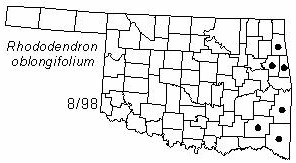Shrub to 1.5 m (5 ft) tall. Crown open. Twigs gray to red-brown, glabrous. Leaves alternate, simple, leaves rotate terminally; oblong, obovate, or elliptic, 2.5-5 cm (1-2 in) long, 12-25 mm (0.5-1 in) wide, widest above the middle; firm and thick; puberulent above, pubescent along the veins beneath; color dull green above, paler beneath; gradually narrowed at base, acute at apex, margin entire, slightly revolute, ciliate with short white hairs. Flowers whorled clusters, pedicels 3-6 mm (0.1-0.2 in) long and glandular-hairy, 2.5-5 cm (1-2 in) wide; calyx 5-lobed, ovate, glandular-hairy; petals long, tubular, flaring into 5 lobes, white, glandular hairy; stamens 5, exerted; flowers appear in March after the leaves. Fruits capsules, about 10 mm (0.4 in) long, elongate, covered with stiff glandular hairs.
Distribution: occurs in Oklahoma, Texas, and Arkansas. Uncommon, restricted to eastern Oklahoma.
Habitat: moist, sandy, acid soil.
NWI status: FACW,FACW+
Comment: Rhododendron means rose tree; oblongifolium refers to the oblong leaf shape. Flowers very fragrant.
Field identification: there are two species of Rhododendron in eastern Oklahoma. Texas azalea has glabrous twigs, unlike wild honeysuckle (Rhododendron canescens) which has canescent-pilose twigs.
Horticulture: Texas azalea can be propagated by soft root cuttings.
Wildlife benefits: Rhododendrons are a nectar source for hummingbirds.
Distribution in Oklahoma: 
BACK
NEXT
RETURN TO INDEX
Last update: 9/17/99
 Go to Oklahoma Biological Survey Home Page
Go to Oklahoma Biological Survey Home Page
 Disclaimer
Disclaimer